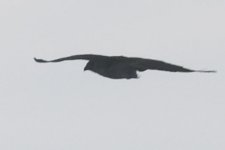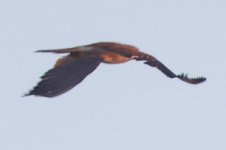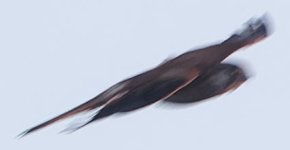Aladdin
Well-known member

Dear Members and Bird watchers!
Indian Ocean - 560 km NW of Australia
Two days ago and had been waiting for birds for a few hours with nothing. I was feed up and I turned around to clean my tea cup.
When I turn around there are two White-tailed Tropicobirds over deck, but I miss to take pictures. After this I keep a sharp lookout.
And today, suddenly I had a falcon just in front of me, I do not know where it came from. I was shocked and by the time my camera was ready the bird showed the BEHIND flying (picture 4) in to the sun towards Australia 560 km to SE.
Picture was very poor. The bird turned in to a small dot on the sky. I sit down and this time I keep the camera in my lap.
The bird looking like it was crying, red rusty coloured. And I'll be darned, I see another Falcon 10 minutes later, (picture 5 and 6) just appear from an empty sky and it is flying towards SW turning in to a small dot.
Must have been 2 birds as I do not think it was the first coming back but I just reported it as one, falcon sp. But for me it was a Nanteen Kestrel, but I do not want to report any birds I am not sure off.
Is it possible to confirm the ID from my at least to say poor pictures?
And if it is a Nanteen Kestrel, what on earth is the bird doing in the middle of the Indian ocean?
Kind Regards and Happy Birding!
Aladdin
,
Indian Ocean - 560 km NW of Australia
Two days ago and had been waiting for birds for a few hours with nothing. I was feed up and I turned around to clean my tea cup.
When I turn around there are two White-tailed Tropicobirds over deck, but I miss to take pictures. After this I keep a sharp lookout.
And today, suddenly I had a falcon just in front of me, I do not know where it came from. I was shocked and by the time my camera was ready the bird showed the BEHIND flying (picture 4) in to the sun towards Australia 560 km to SE.
Picture was very poor. The bird turned in to a small dot on the sky. I sit down and this time I keep the camera in my lap.
The bird looking like it was crying, red rusty coloured. And I'll be darned, I see another Falcon 10 minutes later, (picture 5 and 6) just appear from an empty sky and it is flying towards SW turning in to a small dot.
Must have been 2 birds as I do not think it was the first coming back but I just reported it as one, falcon sp. But for me it was a Nanteen Kestrel, but I do not want to report any birds I am not sure off.
Is it possible to confirm the ID from my at least to say poor pictures?
And if it is a Nanteen Kestrel, what on earth is the bird doing in the middle of the Indian ocean?
Kind Regards and Happy Birding!
Aladdin
,










